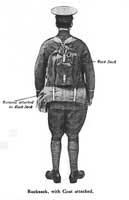Sam Browne Trade Patterns, subdued: Thresher Leather-Drill Sam Browne
Introduction
 Though this form of Sam Browne equipment was long-known, KW are indebted to Geoff Carefoot for a Thresher & Glenny catalogue plate, from 1918, which makes mention of their Thresher Leather-drill Sam Browne Equipment. At last there is a trade-name than can be ascribed to these items.
Though this form of Sam Browne equipment was long-known, KW are indebted to Geoff Carefoot for a Thresher & Glenny catalogue plate, from 1918, which makes mention of their Thresher Leather-drill Sam Browne Equipment. At last there is a trade-name than can be ascribed to these items.
Officers’ equipment being private purchase, such things did not appear in the Priced Vocabularies, which means no nomenclatures can be ascribed. Fortuitously, this catalogue entry gives a nomenclature of sorts and, even as a trade name, it is at least a discrete “nomenclature”. Presumably, the complete “Sam Browne” set of Belt, Braces, Pistol case, Ammunition pouch, Sword frog and Sword steadying strap received a covering of drab khaki-drill material. Of these, only a Case, pistol can be illustrated, so KW readers are hereby asked to fill in the gaps!
The khaki drill material is not simply a cover on the component, but is tightly fitted and permanently bonded to the leather. Until other examples of the Leather-drill Sam Browne surface, reference can be made to the all-canvas type, covered under Trade Pattern Type A. The outward appearance and shapes cannot have been that different.
The Thresher and Glenny plate is the more interesting for also illustrating two forms of Rucksack, with mention of a third “…regular pattern…”. In the flat, the envelope of the Square Rucksack was of that form, made of waterproof cotton drill, with canvas shoulder straps permanently stitched to the top edge. These were angled outwards for a better “sit” on the wearer’s back. The running ends of the shoulder straps were made of leather, adjustable through a single roller buckle on the right side and a buckled adjusted metal loop, which attached to a hook mounted at the base of the Rucksack. This German style of attachment allows for the Rucksack to be slung on one shoulder, pulled over the other, the strap then being hooked on. It is more usual to favour right-handed people, in that the hook should have been on the right side! A single external pocket was provided, with a leather strapped flap and the main envelope was eyeletted, in kit bag style, to be drawn up tightly under a very abbreviated flap.
A de luxe version, the Waterproof Rucksack, with a separate waterproof lining foreshadowed the means that would be used in Patt. ’44 W.E. , even to the coat straps fitted to the base. It is not clear if these were attached, or separated, in leather loops. Alone of the few advertisements seen, this is quite blunt in its approach, with reference to an officer being a “…marked man…”. The Canvas Rucksack, regular pattern is almost half the price of the Square rucksack, so must have been much simplified, perhaps with both shoulder straps buckled and no external pocket. For such a reduced price, the envelope material was probably of a lesser and non-waterproof quality.
© R.J. Dennis February 2009